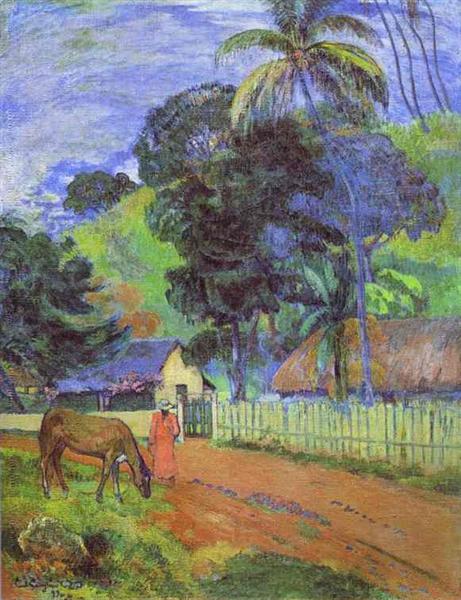Description
In 1899, Paul Gauguin, one of the most influential precursors of modernism and a leading member of the Pont-Aven School, created a work that captures not only a landscape but also an emotional state through his distinctive use of color and form. "Landscape - 1899" is a testament to his exploration of the natural world, a concern that is manifested in his post-impressionist style, characterized by the radical use of color and simplification of forms.
The composition of “Landscape – 1899” is characterized by the harmonious arrangement of natural elements, where rolling hills appear to intertwine with a vibrant sky. The use of saturated and pure colors is distinctive of Gauguin, who rejected the subtle nuances of more traditional Impressionism in favor of a palette that evoked direct emotions and vivid sensations. Here, intense greens and bright yellows are observed, contrasting with some bolder notes of blue, thus creating an almost exotic environment that invites the viewer to a sensorial experience beyond the merely visual.
In the landscape, no human figures appear, which is an interesting and revealing aspect. In many of his works, Gauguin inserted characters that often symbolized his interest in primitivism and the cultures he explored in Tahiti. However, in this painting, the silence of the natural environment and the absence of humanity inhabiting it suggests a search for a direct connection with the essence of the landscape itself, without the intermediation of a narrative or social context. This approach contributes to the creation of an almost spiritual atmosphere, where nature is the main subject and the viewer becomes part of the dialogue established between the canvas and its observer.
The structure of the painting, with its use of lines and modulation of colours, seems to communicate with other works by Gauguin, in which symbolism and emotion are intertwined. As in his famous Tahiti series, where colours often contained emotional or spiritual meanings, "Landscape - 1899" presents an embellished nature charged with visual symbolism that invites us to contemplate not only the representation of a place, but also the emotional reaction it provokes.
Gauguin's interest in a more stylized and less naturalistic approach is also evident in the way he depicts vegetation and landscape features. The masses of color are not modeled after a realistic or exact pattern, but flow and combine to create an effect more in keeping with the artist's inner perception. This approach prevents the piece from becoming a simple representation of the outside world and allows it to rise to a more universal expression of beauty and contemplation.
"Landscape - 1899" is, in short, a work that encapsulates Gauguin's desire to go beyond mere visual representation and connect with the emotional depth that the landscape can evoke. Through his poetic technique and his intimate relationship with color, the painter not only invites us to look at a landscape, but to feel it deeply, to experience what it can mean to be in the midst of nature in its purest and most evocative form. Thus, this work stands as a milestone on the path towards a new way of seeing art, a bridge between impressionism and what became modernism, marking an important step in the evolution of the visual language of the 19th century.
KUADROS ©, a famous painting on your wall.
Hand-made oil painting reproductions, with the quality of professional artists and the distinctive seal of KUADROS ©.
Painting reproduction service with satisfaction guarantee. If you are not completely satisfied with the replica of your painting, we will refund 100% of your money.

